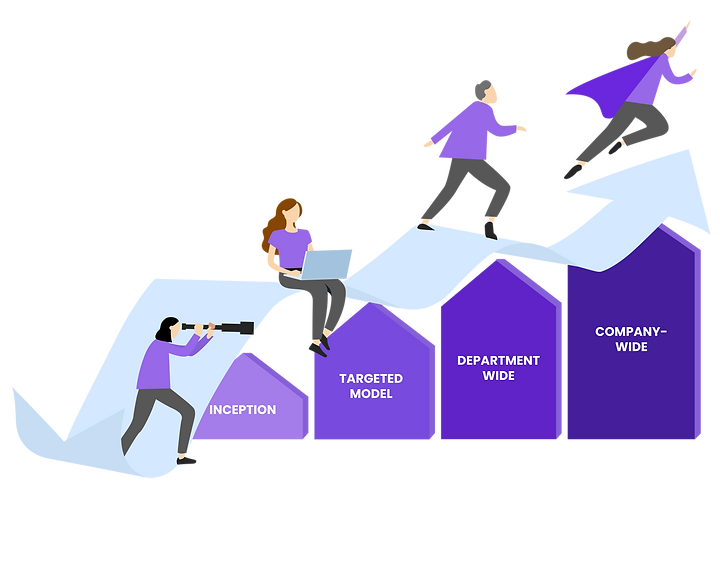

The Mentra Publication
How Neuroinclusion fits into your DEI strategy
TL;DR
-
Understanding the integration of neuroinclusion within DEI strategies
-
Expanding DEI initiatives to embrace neurodiversity
-
The hidden challenges companies encounter in fostering neuroinclusion
-
Navigating the path toward achieving neuroinclusion
-
Strategies for bridging the neurodiversity divide in your organization
How neuroinclusion fits into your DEI strategy
Welcome to a new age – an era where we embrace the varied skills and talents of all people, as well as our unique neurological makeup. We're calling it the age of neuroinclusion.
As HR professionals, we’ve seen the signs.
The pulse of the corporate world is changing, and it’s calling us to approach talent acquisition and management in innovative ways.

The workforce is diverse, and it's becoming more evident that diversity goes beyond race, gender, and age. It extends into the realm of our neurology.


Neuroinclusion: Beyond Traditional DEI
In a world where recruiters and HR leaders are continually refining strategies to optimize talent acquisition, neuroinclusion emerges not as a fleeting trend but as the next strategic milestone. While Diversity, Equity, and Inclusion (DEI) efforts have traditionally given precedence to factors like race, gender, and age, it's clear that a broader understanding is needed. Cognitive diversity, derived from neurodivergences like ADHD, autism, and dyslexia, presents a groundbreaking opportunity in achieving a holistic DEI.
Embracing this expansive view of diversity ensures that we recognize, value, and harness the unique strengths and perspectives that neurodivergent individuals bring to the table.


Hiring Neurodiverse Talent is Essential For Business Success
In essence, embracing neurodiversity isn't just an ethical imperative; it's a strategic advantage that can significantly contribute to a company's long-term success. By hiring neurodivergent talent, you stand to gain from the following benefits:
-
Driving Innovation: Neurodiverse teams bring fresh perspectives and problem-solving skills, fostering innovation and creativity.
-
Boosting Productivity: Neurodivergent employees have shown a 48% increase in productivity compared to their neurotypical peers, making them valuable assets to the workforce.
-
Enhancing Retention: Embracing neurodiversity reduces turnover rates by up to 30%, saving businesses resources in recruitment and training.
-
Expanding Customer Base: Approximately 1 in 7 people worldwide is neurodivergent, making it crucial for businesses to have diverse teams that can better connect with and serve a broader customer base.
In summary, hiring neurodiverse talent makes business sense.
The Invisible Challenge companies face

The problem we face today isn't one of visibility, it's of understanding. Neurodivergent talent – those with invisible disabilities – often remain underrepresented in companies because of our conventional ways of thinking about work, productivity, and talent.
1 Lack of Empathy:
We, as companies, often struggle to understand how neurodivergence intersects with one's performance and well-being. Employees may be aware of neurodivergence but might lack the empathy to understand the associated strengths and challenges. Moreover, recognizing how to support neurodivergent colleagues effectively remains a hurdle.
2 Misaligned Hiring Systems:
Traditional hiring practices, which rely heavily on keyword matching, are often ineffective at recognizing the unique talents of neurodivergent individuals. We need systems that look beyond traditional measures and appreciate the diverse ways in which aptitude can manifest.
3 Absence of Psychological Safety:
Companies often lack a culture of psychological safety that encourages employees to be their authentic selves. The pressure to "mask" one's unique neurology can lead to burnout and turnover.
Recognizing the Gap and Embracing the Shift
If companies continue to ignore the one in seven humans who are neurodivergent, they're missing out on a wealth of diverse thinking. When neurodivergent employees are supported and their unique talents are utilized, companies can thrive in unprecedented ways. Companies have now started to recognize the need to tap into this vast, untapped talent pool.
However, many companies echo concerns: limited budget, insufficient staffing, lack of knowledge, scaling issues, and training needs, among others.

These concerns, while valid, signal a company's unreadiness to embrace the neurodivergent workforce fully.
On the other hand, companies showing signs of progress - executive buy-in, expanding neurodiverse programs, inclusive Employee Resource Groups - are the ones leading the change.
The Road to Neuroinclusion

The path to neuroinclusion begins with introspection.
Companies need to evaluate their current workforce dynamics and work environment. They should understand their neurodivergent employees' experiences and actively work to create a safe, supportive environment.
Key questions to ask could include:
-
How many employees have disclosed their neurodivergence?
-
How long did it take for them to feel comfortable disclosing?
-
How easy is it to get access to necessary accommodations and support?
-
How would neurodivergent employees rate their relationship with their manager?
-
Do employees feel psychologically safe at work?
-
Is the leadership at the organization is championing neuroinclusion?
Remember, factors that lead to dissatisfaction and turnover among neurodivergent employees often affect neurotypical employees too... it just takes longer. If we can crack the code on neuroinclusion, we will solve wider issues of employee turnover (in fact companies in the US pay $1 TRILLION in turnover) and human dissatisfaction.
Bridging the Neurodiversity Divide
The landscape of corporate inclusivity is at a crossroads. Today, numerous companies grapple with the efficacy of their Neurodiversity Programs, wondering if they're truly making an impact. While the foundational ethos of neuroinclusion extends beyond merely hiring a handful of neurodivergent individuals, it seeks to reimagine workplaces where every role, every opportunity is accessible, and inclusive of neurodivergents. The vision is clear: moving towards a culture of Company-wide neuroinclusion.

As detailed in this Forbes article, programs might be failing us because we’re assuming that programs are the end goal. Instead, hiring programs are the first step in a evolutionary process in the journey towards holistic, end-to-end neuroinclusion. To synthesize this journey into their distinct stages, Mentra has built maturity model, endorsed by the Vanderbilt Frist Center of Autism and Innovation, comprised of the following stages:
.png)
1 Inception:
The dawning phase, where driven by influences like ERGs, disability hiring, or the brave unmasking of employees, leadership and managerial ranks start their foray into understanding and valuing neurodiversity.
2 Targeted:
One or two enlightened champions take the lead, possibly adopting a program model or a specialized team approach to bring on board neurodivergent talents for 1-5 key roles.
3 Department:
This phase witnesses an acceleration in momentum. Department heads, now converted champions, steer the hiring of neurodivergents across diverse functions, ensuring integration at every level.
4 Company-wide:
The zenith phase, where the organization's collective spirit, from top brass to the rank and file, endorses and extols neurodiversity. Neurodivergent talents aren't just integrated but actively pursued for every role, right up to the echelons of leadership.
Mentra, having worked with over 15 large Enterprises companies across a variety of industries, has keenly observed and studied these stages, and is ready to support employers with embarking on this transformative journey. Leveraging a combination of gap analyses, partnerships with training providers, and unique hiring technology,
Mentra has built a safe space online for neurodivergents to discern and celebrate their unique strengths.


Regardless of where our organization is on the journey, Mentra provides companies with the strategic roadmap to evolve to go from pilot initiatives (often confined to a 1-3 hires in specialized roles) to the large-scale integration of neurodivergent talents across multifarious departments and roles.
If neuroinclusion is your destination, Mentra can be your guide. You can take the first step by scheduling an introductory phone call at this link.
The undeniable truth is that neurodivergent talent — who by definition “think differently” — hold a reservoir of untapped potential and innovative perspectives that can significantly benefit an organization. When we weave this diversity of thought into the very fabric of our companies, we're not just changing our workplaces - we are transforming the world at large.
About the Author
Jhillika is the CEO and cofounder at Mentra, a fellow neurodivergent, Forbes 30 under 30 Social Impact awardee, honorary degree recipient and TEDx speaker for diversity and neuro-inclusion. Her experiences as the sister of a non-speaking autistic individual served as a catalyst for Jhillika to cofound Mentra— empowering companies to tap into the talents of those who society often overlooks… the neurodiverse.




